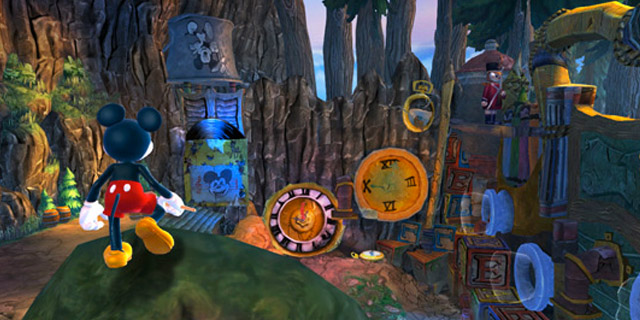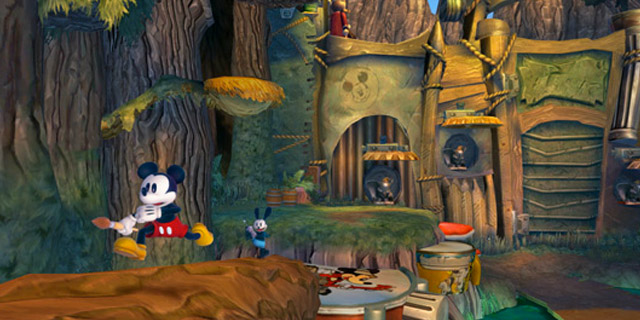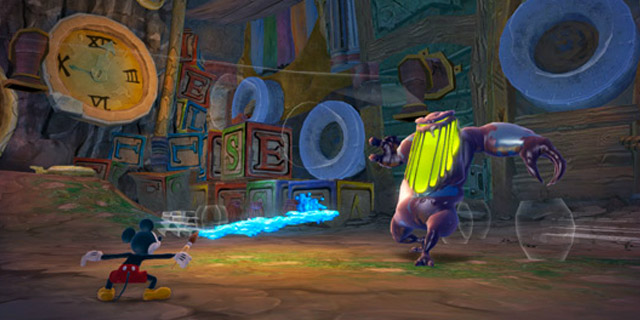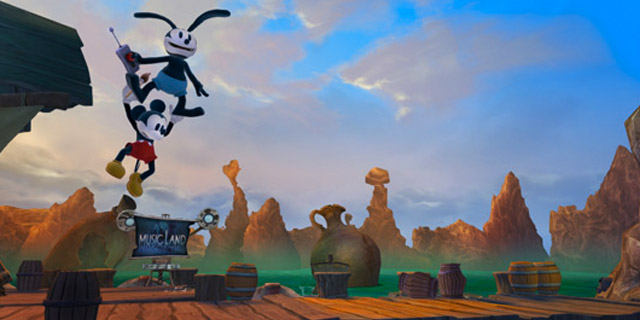
The original Epic Mickey was full of potential. It was clear from the start that the team at Junction Point had a lot of love for Disney, and wanted to make a game that brought back Disney’s past in an original way. It succeeded in how it handled those moments, but failed to create a compelling gameplay experience in the process. With the release of Epic Mickey 2: The Power of Two, Junction Point is hoping to recapture the magic from the first game while improving on some of the fundamental issues that plagued the original. It is clear, however, that this formula is more flawed than I originally realized.
Following the events of the first game, the Wasteland, where all of the forgotten Disney characters live on, is once again under attack by a new force of… let’s just say evil, and Mickey Mouse, being the courageous hero he is, is whisked away back to the strange world in order to save it. The story has its charm, and hearing Mickey and Oswald fully-voiced this time around adds some interesting dynamics between the characters. And then there are the musical numbers provided by the Mad Doctor, the first game’s antagonist who swears he has turned over a new leaf. These moments are just plain fun (and funny) and really showcase that the developers still have plenty of interesting new ways to approach the original’s concept.

Not only that, but this is a pleasant-looking game. The cartoony visuals that benefited the first game return, and look even nicer in HD. The best parts are the 2D animated cutscenes that almost look like they were taken right out of an Epic Mickey cartoon series. They fit perfectly with the game’s style, and really showcase Disney at its highest quality.
The paint and thinner mechanics have returned, and are the main way to deal with puzzle solving and combat. The actual act of making “moral choices” involved with choosing whether to use paint or thinner is barebones at best, and it never really plays into any main morality system like the developers want you to think it will. The actual mechanics of painting or thinning objects in the environment is still neat and can be used in some interesting ways, but these mechanics are never as fleshed out as it seems they could be.
While the combat is never great, the handful of boss battles scattered throughout the game are interesting and introduce new ways to approach the otherwise-tame paint and thinner mechanics. They are fun moments that really showcase what Epic Mickey can be at its best, but once those battles are over, you feel the loss of potential once again as you return to the same mundane combat and platforming.

The 2D stages return, however, and these are actually the most interesting parts in Epic Mickey 2 (as they were in the original). You play through relatively short levels designed around old Mickey Mouse cartoons, many of which are excellent tributes to a bygone era. Not only that, but the levels are enjoyable and have multiple paths to explore. Before you begin each level, you can select one of two different pathways which add to the replayability of these levels. I found myself returning to them just to escape from the otherwise uninteresting level design found in many of the main areas of the game.
The new hook in Epic Mickey 2 is the addition of Oswald the Lucky Rabbit as Mickey’s faithful sidekick. He doesn’t have the same abilities as Mickey does, but can hover and use his special remote to stun enemies and unlock doors and hidden chests. He was added to the game because of the addition of a co-op mode, but playing as Oswald is surprisingly dull and I can’t imagine a second player really enjoying going through the entire game without the central mechanics to work with.

When playing solo, Oswald’s A.I. tends to be more of a problem than any enemies you face. Sometimes Oswald will get in the way during combat, or simply not do something he needs to do in order for you to progress. There are many points throughout the game when you need Oswald to do something to unlock a door or activate a switch, but at least half of those times he would get stuck somewhere else in the level or simply not do what he was supposed to. I was forced to reload from the last checkpoint and that usually solved the issue, but the fact that I had to do that multiple times throughout the game was troublesome. Playing co-op solves this problem, but it would require someone to actually play as Oswald, which, as mentioned earlier, is a bit of a chore.
The Wii U GamePad doesn’t add anything particularly interesting aside from using it as a map, which is rarely useful. The Wii U version does have one exclusive “feature” over the other versions though: awful framerate. Whenever you choose to paint or thin anything, the game’s framerate will slow to a crawl, which can actually interfere with gameplay when you’re trying to perform specifically timed jumps or attacks. This is a huge issue during particular boss battles too, as it can actually hurt your ability to properly dodge specific attacks or perform actions in a set amount of time. It’s a huge issue that turns what could have been the best version of the game into the worst.
Epic Mickey 2, like the original, is a game chock-full of unfulfilled potential. It’s clear from the start that the developers love Disney and treasure the old, forgotten characters just as much as the new stuff. This is a franchise that would make for a terrific and memorable animated series. As a game, however, it falls flat on its face at almost every instance. There are moments of brilliance, but those are few and far between, leaving you with a rather simplistic and somewhat dull platformer with mechanics that aren’t as developed as they should be. This is a game that massive Disney fans will get enjoyment out of, just be sure you avoid the Wii U version at all costs.
Pros: Charming presentation and story, fun 2D levels, interesting boss battles
Cons: Wii U version has atrocious framerate, Oswald’s A.I. gets in the way



















